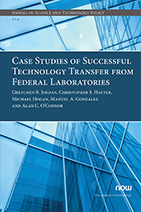Case Studies of Successful Technology Transfer from Federal Laboratories
By Gretchen B. Jordan, 360 Innovation LLC, USA, gretchen.jordan@comcast.net | Christopher S. Hayter, Arizona State University, USA, chayter@asu.edu | Michael Hogan, RTI International, USA, mhogan@rti.org | Manuel A. Gonzalez, RTI International, USA, magonzalez@rti.org | Alan C. O’Connor, RTI International, USA, oconnor@rti.org
Abstract
In the United States, the Federal Government spends around $150 billion annually on Research and Development (R&D) at federal labs, universities, and research organizations. This investment in early-stage R&D together with the technology transfer process strengthened by the Stevenson-Wydler Act makes federal labs an important source of innovation that leads to products and processes with a private and social benefit. In this monograph, we present a structured case study approach to illustrate the benefits of the transferred research and technology as well as the circumstances that influenced the success of that transfer. Technology transfer from federal has widespread public benefits in areas that would not typically be addressed by the private sector and are difficult to quantify. The nine case studies presented span a mix of federal agencies, technology types, and transfer mechanisms. They illustrate a novel approach to matched case study research in this field, and explore the benefits, success factors, and lessons learned for federal managers. Each case presented a unique agency, transfer mechanism, and technology but illustrated some common success factors: deep research expertise, a clear demand environment, existing relationships, and legal mechanisms including licensing and CRADAs increased the likelihood of success. Research from federal labs requires a long-term commitment, but our case studies demonstrate how it can have widespread economic, environmental and public health benefits in addition to commercial benefits to the transfer recipient.
Case Studies of Successful Technology Transfer from Federal Laboratories
Case Studies of Successful Technology Transfer from Federal Laboratories presents a case study protocol and analyses of nine technology transfer success stories across federal agencies and their research laboratories to begin to fill a gap in the existing literature where there is less available research on the impact and the mechanisms of technology transfer from federal labs. The goal is to present a methodology for doing case studies of technology transfer from federal laboratories and showcase a group of case studies done using that methodology. In addition to providing rich insights into different technology transfer processes, analysis across case studies with the same methodology allows one to begin to draw conclusions about similarities and differences in the mechanisms and conditions leading to successful technology transfer from national laboratories.
